Let’s talk about how to write for publications that get millions of readers. But first, it’s important to make clear that getting published in highly popular publications (like Forbes, Entrepreneur, Inc., Business Insider, and Fast Company) will take a ton of upfront work. However, you can follow a basic formula—and the rewards are well worth the time investment it takes to land a publication column.
Because I want to get straight to the point for you, here’s a quick answer that sums up the nuanced approach this ultimate guide breaks down…
What’s the best way to become a contributor to a major publication?
The absolute best way to become a contributor and write for a major publication like Forbes, Entrepreneur, Inc, Fast Company, or Business Insider is to get an introduction to a relevant editor (within your content niche) from an existing writer or contributor to that publication.
Now, we’re going to dig into the step-by-step process for engineering those kinds of meaningful introductions.
How to Write for Publications (and Become a Contributor to Forbes, Entrepreneur, and Inc)
- Get Published on (Smaller) Authoritative Websites First
- Become Familiar with Your Target Publications
- Understand the Publication’s Guidelines
- Build Real Relationships with Current Contributors
- Ask for an Introduction to an Editor at Your Target Publication
Disclosure: Please note that some of the links below are affiliate links and at no additional cost to you, I’ll earn a commission. Know that I only recommend products and services I’ve personally used and stand behind. When you use one of my affiliate links, the company compensates me, which helps me run this blog and keep all of my in-depth content free of charge for readers (like you).
Now, let’s break down my process of learning how to write for publications (in your niche) that will build your personal brand, increase your authority, and drive traffic to your blog over the long term.
1. Get Published on (Smaller) Authoritative Websites First

Like it or not, there are many steps to take before you begin pitching yourself to major publications like Forbes and Entrepreneur.
Among those steps are building your writing skills, developing a portfolio of work that can bolster your credibility, and growing your authority within your niche.
Once you’ve made some headway on these building blocks, the next step is reaching out to other authoritative websites in your niche for guest blogging opportunities. Everything from decently trafficked blogs to smaller industry-level publications and magazines can help boost your personal brand & build up some credibility before you reach out to a major publication editor.
Aim for publishing at least 10-20 reputable guest posts (the more you have, the more compelling your pitch will be), before expecting results if you reach out to one of the top publications in your niche and ask to be considered as a contributor.
How to Find Authoritative Websites in Your Niche
One obvious next question is, how do you find authoritative websites in your niche? Where do you find the sites that would work well for building your credibility in the eyes of larger publications?
Here are a few ways to find websites to send guest post pitches to:
- Leverage an Existing Connection (if You Have One): The easiest way to get your guest post pitch accepted is to already connect with the host blog. You may know the website owner personally, or you may know one of the employees or have some history with a contributing writer there. If you already have an established relationship, it makes it much easier to reach out about a guest posting opportunity—so take inventory of any relationships that can be leveraged to your advantage here.
- Use Social Media: Social media is another very powerful resource for finding authoritative blogs and websites in your niche. Search for keywords, names, hashtags, groups, and followers to find reputable bloggers with an engaged following who may accept a guest post from you (just be sure the blog post idea you pitch will be relevant to their followers).
- Use Google Search to Find Great Sites to Pitch: Google search is an excellent option for finding authoritative websites in your niche. You can find these blogs by searching for target keywords or keyword phrases in your niche. The top hits for these phrases are likely to be higher-quality sources. Take it a step further by clicking on the results and seeing which websites have a lot of high-quality content and a good presentation.
Now, let’s break down my top criteria for finding & evaluating a publication you want to contribute to.
5 Criteria for Choosing Authoritative Websites to Write for (and Build Your Personal Brand)
Not every blog or website will be the best match for you and your branding mission—especially in the early days of executing your longer-term goal of (eventually) becoming a contributor to a major publication in your industry.

When you look for websites to pitch your guest posts to, keep these criteria in mind.
1. Choose Websites With a Similar Style, Tone and Audience
It would be best if you didn’t work hard to match the feel of the website you’re writing for. If their blog is completely different from your blog in every conceivable way, then you’re probably not seeking to reach the same audience—and your efforts would be best suited elsewhere.
Look at their overall site design and observe their content’s tone and style. Is it at least somewhat similar to your own? If not, you’re probably not going to be a good fit for each other.
2. Write Guest Posts for Websites That Offer a Follow Backlink
Most places that you can guest blog for will allow you to include a “follow” backlink or two, pointing back to your blog in either your author bio and/or within the article itself. In some cases, though, they may choose to use a “nofollow” link instead. While the link will still lead to your blog, keep in mind that it won’t help you in terms of your blog’s SEO efforts.
Before you write a guest post for another blog or website, ask about their guidelines. In most cases, it isn’t in your best interest to write for a website that either uses a “nofollow” link or does not allow you to include a link at all. You should be getting something out of the free content you’re providing, so I recommend moving on if there isn’t an opportunity to get a link from the site you’re pitching.
If you can’t find their guidelines about this, check out past guest blog posts and scroll to the author bio section… right-click on the backlink provided in the bio and select “Inspect” if you’re using the Google Chrome browser. This will let you see the HTML code for the hyperlinked text, like so:

If you see the word “nofollow” in the HTML description of the link, then you know it’s a “nofollow” link.
And while some of the biggest publications out there (like Inc, pictured above) will automatically nofollow all external links within the articles they accept from contributors, you stand to gain in terms of traffic to your website and the personal branding benefits of being featured on major publications. When it comes to smaller sites, think long and hard before writing for them (for free) without getting credit in the form of a link back to your blog.
3. Pitch Blogs You’d Be Proud to Get Published on (They’ll Add to Your Credibility)
Always try to find blogs that you’d be proud to be associated with. If you think their blog is poorly designed, has a point of view that you don’t support, or just has content that’s of poor value, then don’t write for them.
A well-designed blog layout with high-quality content and a worldview you align with will add the right kind of credibility to your blog.
4. Find Blogs in a Similar Niche
Another important consideration is whether or not the blog you want to write for, is in a similar blog niche as your own.
Are you writing for similar audiences? If you can’t find a connection between your niche and theirs, then you’re not going to drive as much (relevant) traffic back to your blog once a guest post goes live.
5. Send Your Pitches to Larger Sites
Your goal is to guest post for a blog that’s larger than your own… but not so large that you don’t stand a chance of having your pitch accepted. As your blog grows, the size of the target website that you want to write for will also grow.
When you pick a blog that appears to get more traffic than your site does, you can gain valuable exposure to more readers in your target audience—in addition to building meaningful momentum toward your eventual goal of becoming a contributor to a publication.
How to Estimate the Popularity of Another Blog (or Website)
One crucial piece of information you may not be able to glean immediately is how to discover how much traffic another website receives. Unless they publish their Google Analytics, there’s a good chance that you won’t know precisely how popular their website is by a quick glance. That’s where tools like Alexa Traffic Rank come into play:

Here are three of the most popular tools for uncovering how successful another blog is:
- Alexa Traffic Rank (Free)
- The Ahrefs Tool Suite (Paid)
- SEMRush (Paid)
For a more in-depth tutorial on guest posting, my guide Guest Blogging 101, covers everything you need to know about guest posting from start to finish, including:
- What is guest posting?
- How to find the perfect blogs to post on
- How to come up with guest blogging ideas
- How to pitch your guest post
- What to do once your post goes live
These ideas are similar to learning how to write for a publication like Forbes and Entrepreneur. Still, guest posting for smaller authoritative websites is a crucial stepping stone to larger publications.
2. Become Familiar with Your Target Publications
Becoming very familiar with your target (dream) publication is another important foundational step in the lead-up process of eventually getting published. The more you know about the popular publications you want to write for, the more you’re going to be able to add the right kind of value to them during your pitching process.

Spend time over the coming weeks (and months) reading a good amount of content your target publication is releasing. As you’re going, keep in mind that there are a lot of important insights you can glean from reading the work they allow their contributors to publish. Take note of crucial things like:
- Topics that successful contributors frequently cover
- Which types of stories tend to get the most traffic (or social shares)
- Headline format, tone, and capitalization use (you can use a free tool like Title Capitalize to be extra safe)
- The typical writing style contributors have
- Length of the content that’s usually published
- Overall tone, voice, and style of the writing
- Who some of the most regular contributors are (make a list)
For example, take one of the most popular articles I wrote on my Forbes column (about how I’ve built a blog that generates upwards of $50,000/mo in revenue).
On Forbes, they actively display how many times an article has been read—so you can see just how popular it is, and thus learn some key lessons about what makes content perform well (or not) on publications like Forbes:
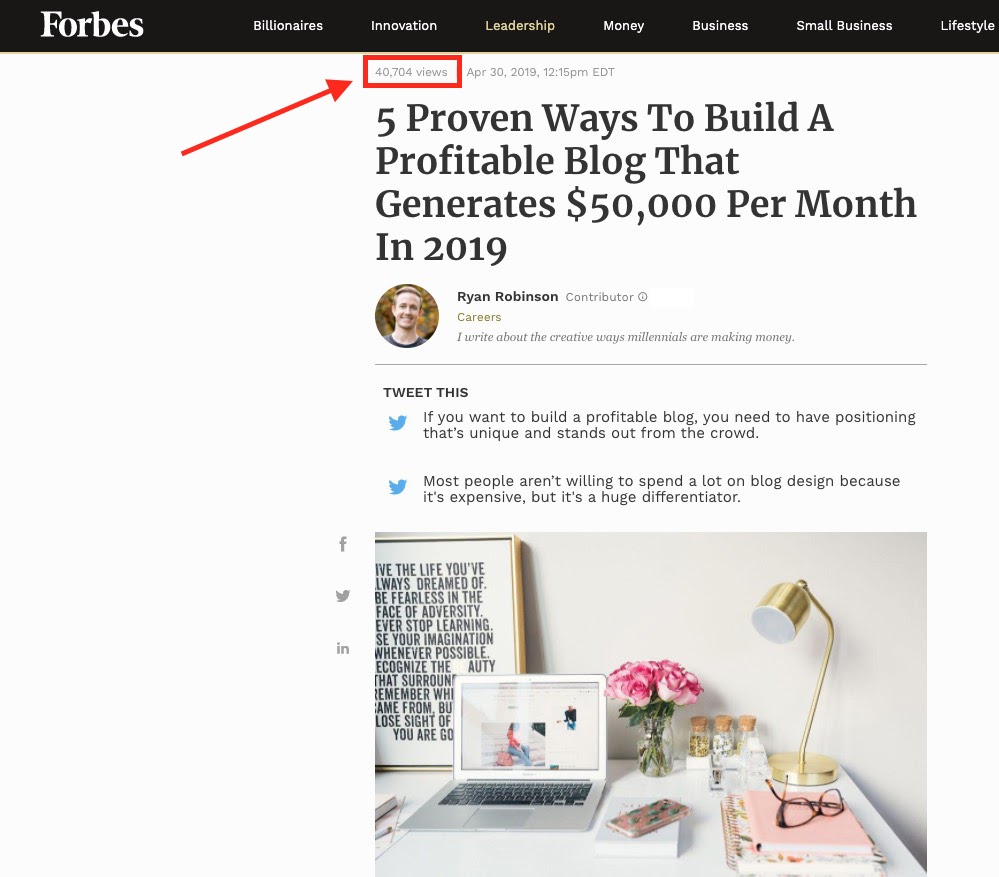
Another important element of studying your target publication is learning exactly who does the writing.
As you get to know the writing of certain contributors, journalists, or writers that you resonate with—you can learn more about what style of writing the publication is seeking. At the same time, you’ll be preparing yourself to be in a good position to eventually reach out to some of these existing contributors and try to build relationships with a handful of them.
3. Understand the Publication’s Guidelines

Before you can start effectively pitching yourself to a major publication, pause and first look for any clear contributor guidelines that may be available online.
Major online publications receive submission requests from many people (think literally thousands every single day). Because of the sheer volume of requests, some big publications share super clear guidelines for would-be contributors right on their sites.
Forbes doesn’t publicly display explicit contributor guidelines on their website, but Entrepreneur does:
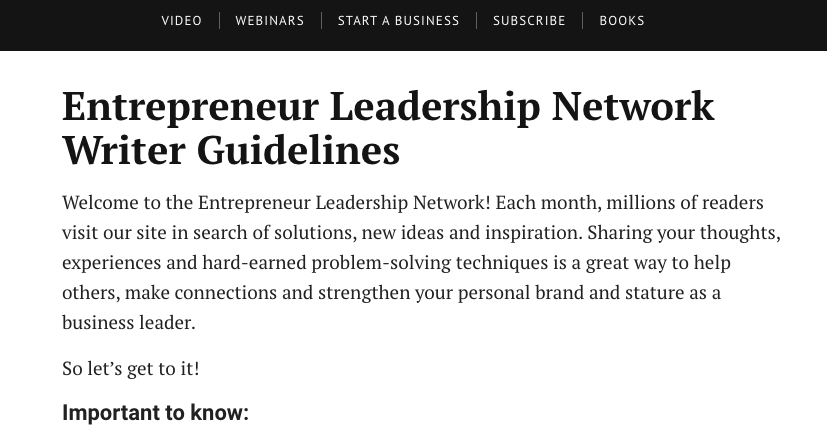
Some of the highlights of what an Entrepreneur is looking for in contributor-written articles include:
- Something unique with a distinctive message (not something that has been covered extensively on the site already)
- No interviews or quotes unless from a notable individual or household brand
- Content like inspirational pieces, trend pieces, or advice pieces
- Valuable advice that readers can actually use (no fluff)
- Trustworthy sources and accurate attribution
- New original pieces (not something you’ve previously submitted or written for your own blog first)
For example, here’s a snapshot of a piece I wrote for my Entrepreneur column a couple of years ago:

Here’s what Inc has to say about how to become a contributor on their platform:
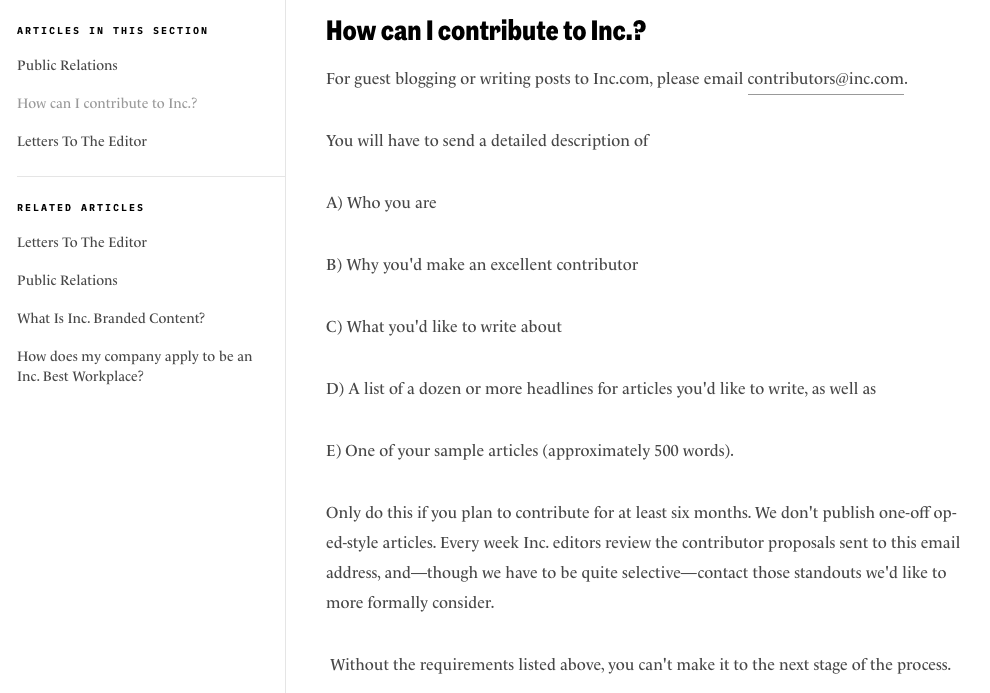
Inc’s help center offers comparably little insight into the submission process for becoming a contributor on their platform. Generally though, when you send a submission to Inc, they want to know some key basic information about you and your writing, like:
- Who you are
- Why you’d be an excellent contributor
- An idea of a main beat or topic area you’d like to focus on (and why)
- A list of specific topics (including a dozen of more headlines) that you could cover
- A sample of your writing (500 words)
One more important thing to note about Inc, in particular, is that they don’t accept “one-off op-ed-style articles.”
Suppose Inc decides to take you on as a writer. In that case, they expect contributors to write consistently for at least six months, typically with a minimum number of monthly articles (usually six pieces) that you’re expected to deliver in order to maintain your contributor status. While you are paid for writing these articles, their payout tends to be very low (think less than ~$100 per article on average) compared to what you’d command if writing the same content for a client company as a freelancer or consultant.
For every example of how a publication selects their contributors, though, there’s always a counterexample.
Fast Company operates on much more of a one-off pitching model, where even well-established contributors are expected to pitch their editors with each individual new story idea whenever they’re ready to contribute another article. This is very different than the way many other publications function, whereby granting every contributor access to an internal CMS and giving them the keys to publish or submit articles for review whenever they’d like (the way publications like Forbes, Entrepreneur, and Inc all provide).
Here’s an example of an article I contributed to Fast Company a couple of years ago, which I had to pitch directly to my editor before even getting started on the writing process:

With Fast Company, once an editor accepts a story idea and outline, rough drafts often undergo a pretty extensive editing process, too—and your blog headline is typically subject to a few rounds of rewrites from multiple editors as well.
Now, public guidelines about how to write for publications like Forbes, Entrepreneur, and Fast Company aside… there’s always the possibility of opening a side door for yourself rather than going through a formal process where hundreds (if not thousands) of other people are vying for the limited attention of editors.
Above all, understand that the best way to write for a major publication (like Forbes, Entrepreneur, Inc, Fast Company, or Business Insider) is to get an introduction to a relevant editor from a current writer or contributor.
Now, let’s discuss this approach in more detail—because it’s consistently cited as one of the most successful routes into writing for top online publications.
4. Build Real Relationships with Current Contributors

The best way to become a contributor for a major publication, is to invest in creating real relationships with people who are currently contributing. If you’re not already friends with someone who’s a contributor at your dream publication, let’s dive into some genuine, attainable, tangible ways you can try and get to know some of them in an authentic way.
Decide Which Contributors You Want to Connect With
First and foremost, start by making a shortlist of contributors who’ve authored any pieces you can presently think of as having actually read in the past (and that you genuinely enjoyed).
If nobody immediately comes to mind, that’s ok too—most contributing writers aren’t exactly household names. If you’re drawing a blank at this stage, set aside some time to browse through the section on the publication that you most identify with (and would be excited to contribute to).
Sift through a couple hundred or so recent articles for headlines that jump out at you, and take note of the contributor names that (1) come up most frequently and (2) are connected to your favorite headlines or topics. If you resonate with the person behind a few articles you like and feel you could connect with them meaningfully, then jot their name down.
These are strong possibilities for the people you’ll want to consider connecting with—and for attempting to form a value-driven relationship with.
Find Your Target Contributor’s Social Media Accounts
Most writers on major business publications in particular, are actively trying to build their own brand and frequently use social media to do so. While they’re not likely to use every single social media platform out there, those who write for publications like Forbes, Entrepreneur and Inc are often active on platforms like Twitter and LinkedIn.
If you read an article on one of these publications and you like the writer’s style, you can often find ways to connect with them in their bio.
Now, let’s walk through an example. Here’s an article titled “The Bezos of Black Wall Street,” written by Antoine Gara.

The article is about the thriving Black community in Tulsa, Oklahoma, that was burnt to the ground by local white residents in 1921. Often overlooked in US history, this event would later become known as the Tulsa Race Massacre, in which up to 300 black Tulsa residents were murdered, and a thriving neighborhood of the city was destroyed.
Now, let’s say you really resonate with the importance of spreading the word about this troubling historical event and write about similar topics on your own blog.
If you want to connect with this writer, you can click on his name at the top of the article, or you can scroll to the bottom (where the author bio is located on Forbes pieces) to see clear ways to contact him.
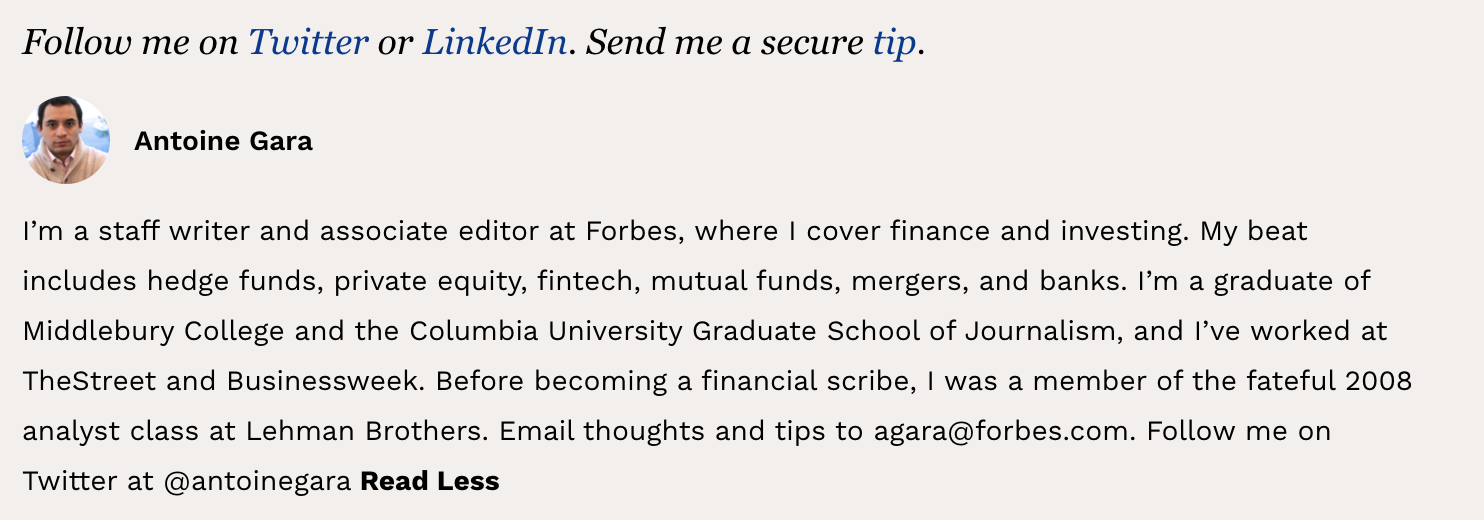
This writer gives three ways to connect with him—Twitter, LinkedIn, or through message.
Now for another example, here’s an article on Entrepreneur about 3 Ways to Support Minority-Owned Businesses:

The publication Entrepreneur gives people a similar way to contact their contributing writers (via clickable links and contract information in the bio section of an article). As you can see, a short bio is included here for contributor Gregg Bishop, as well as links to his Twitter and Instagram accounts.

Inc magazine doesn’t make it quite as easy to connect with their writers or contributors, but they usually list their Twitter handle at the beginning of the article.
Here’s an Inc article I wrote (that was syndicated by contributing editor Jeff Haden) called “Why You Should Freelance While Keeping Your Full-Time Job,” and is based on my original piece:

At the top of the post, you can see the @Jeff_Haden tag, which links to his Twitter account—and from there you can navigate to his website where there are plenty of options to connect with him.
For an in-depth tutorial on doing effective outreach (including how to find anyone’s email address), check out my guide to blogger outreach here.
Use Google Search to Learn More About Contributors
Any contributor you’re interested in connecting with can also be searched on Google. You can find other publications they’ve contributed to, their personal websites (or blogs), and news articles featuring them.

For example, Jeff Haden who worked with me in the article above for Inc, also spoke at a TEDx talk in 2019 titled, “The Most Successful Person in the World.”
He’s also an author of the book, The Motivation Myth, which is a very valuable insight to incorporate into any outreach you may plan on doing.
Why is it Worth Researching Contributors Before Reaching Out?
You may be wondering why I recommend looking up contributors before contacting them. The main reason is to get to know them better before you reach out.
It’s helpful to become familiar with a contributor’s style, tone, and accomplishments before you send them a message. It’s also important to make sure that you have similar viewpoints to confirm that your values appear to align. This will give you fuel to think about how you can be helpful to them.
Here are some questions to ask yourself when researching contributors:
- What commonalities do you share with the contributor?
- What work have you done in the past that’s similar to their interest areas?
- Do you personally like their writing or the topics they cover?
- Would you be excited to work with them?
- Would you feel comfortable associating your name with theirs?
These are by no means the only questions to ask yourself when researching a contributor, but they’re a starting point for collecting relevant information that’ll help make your outreach as genuine as possible.
Reach Out to a Small Handful of Contributors
Once you’ve learned enough about a few contributors you’d like to try connecting with, the next step is to… well… contact them!

The main message you want to get across is that you can provide real value to them.
Showing contributors how you can first help them is vastly more appealing than people reaching out to them for help—and sets the best possible tone for the relationship.
One important consideration in all of this is to be genuine and sincere. As a recipient of dozens of outreach emails every day myself, I truly can’t stress this point enough. A (busy) contributor to your dream publication likely has many competing priorities, so taking time out of their day to reply to your email is something to be appreciated greatly.
Just as it’s essential to maintain a genuine relationship with your blog readers, the same care should be taken when networking.
Nobody wants to feel like they’re being used. Nor would they choose to work with someone who’s only contacting them with the clear intention of getting something out of them right away. That’s why I stress adding value first and not having unrealistic expectations about where the relationship will lead.
How do you offer something of value to the contributors you’re contacting?
Here are a few ways you can try to add value to a contributor before you reach out.
1. Comment on Their Blog Posts or Social Media Content (Regularly for a While)
Before you contact a writer or contributor directly, you can take a little time to comment (ideally regularly) on their blog or social media content first. If they have a blog, I definitely recommend starting there—but social media can also work if they’re active and appear to engage with their followers.
When you leave comments, try to write something that genuinely adds something of worth. If you don’t have anything meaningful to write, wait until there’s a topic you’re personally familiar with—or find another post in their archives that you can relate to.
Connecting this way (at first) is less formal than an email and doesn’t necessarily require any “work” for them to do either. However, it works as an introduction, and they can get to know you through your comments. They may also check out your blog if you leave a link back to your site.
Here’s an example of a fellow blogger, Luis, commenting thoughtfully on my blog. They added to the conversation, asked questions and were generally engaging about the topic at hand:
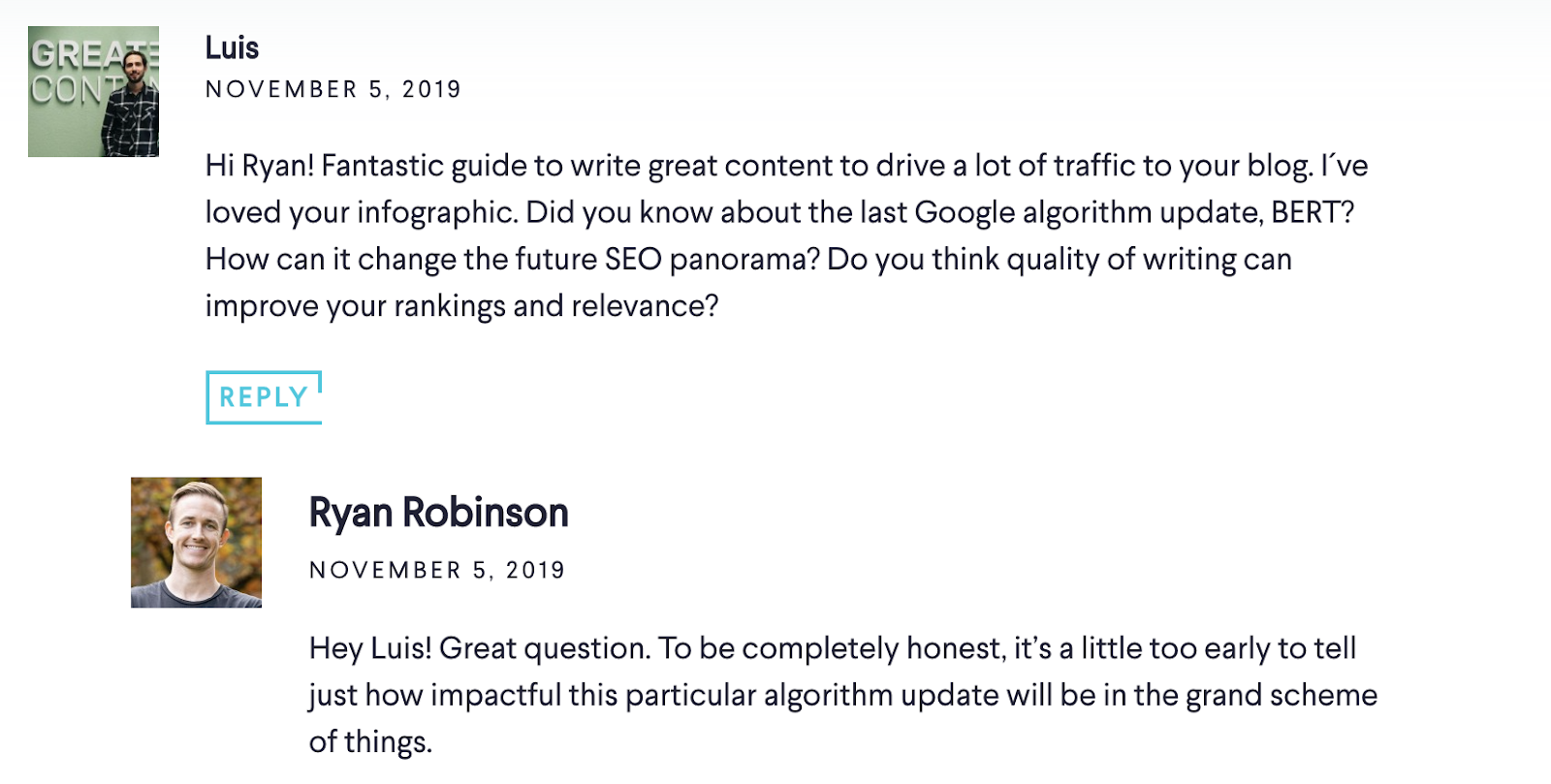
This commenter shows his understanding of more complex blogging topics and shows a real interest in both my article & the overall topic area… which motivates me to want to interact with him.
Other ways that you can begin reaching out to contributors to publications include:
- Rating and reviewing them on iTunes if they have a podcast
- Watching videos on their YouTube channel and leaving thoughtful comments
- Reviewing their books on Amazon or GoodReads
- Providing a testimonial for a product or service they’ve made (an example may be a course you’ve taken or a book you’ve purchased)
No matter how you’re interacting with these contributors, be sure it’s something they’re likely to see at some point personally—and do your best to ensure your name (or profile image) sparks at least some familiarity over the weeks or months to come.
2. Share Their Content on Your Own Social Channels
Sharing the content a particular contributor has written (both for the publication and elsewhere online) through your social media channels is a good step forward… but it probably shouldn’t be the only value you add.

If you have a large social media following (and can drive some engagement with the contributor), this may be a very desirable and noticeable value-add to the contributor. But it may not be as appealing if you have a small following and your social media shares don’t convert into an uptick in mentions or traffic for the contributor.
Remember, your goal is to provide value in the ways your contributor (likely) wants to receive it. This leads me to my next point…
3. Mention Contributors in an Article You’re Writing
Mentioning contributors directly in your own blog posts (or in the guest posts you write for other authoritative websites), is another easy way to offer real value to them.
It’s relatively low effort, but it can also be extremely effective if you have a decent number of readers either on your own blog or on the site where the article gets published. I’ve used this outreach approach many times to successfully build relationships with influencers (and help grow my blog) over the years. Here’s an example of that approach in practice:
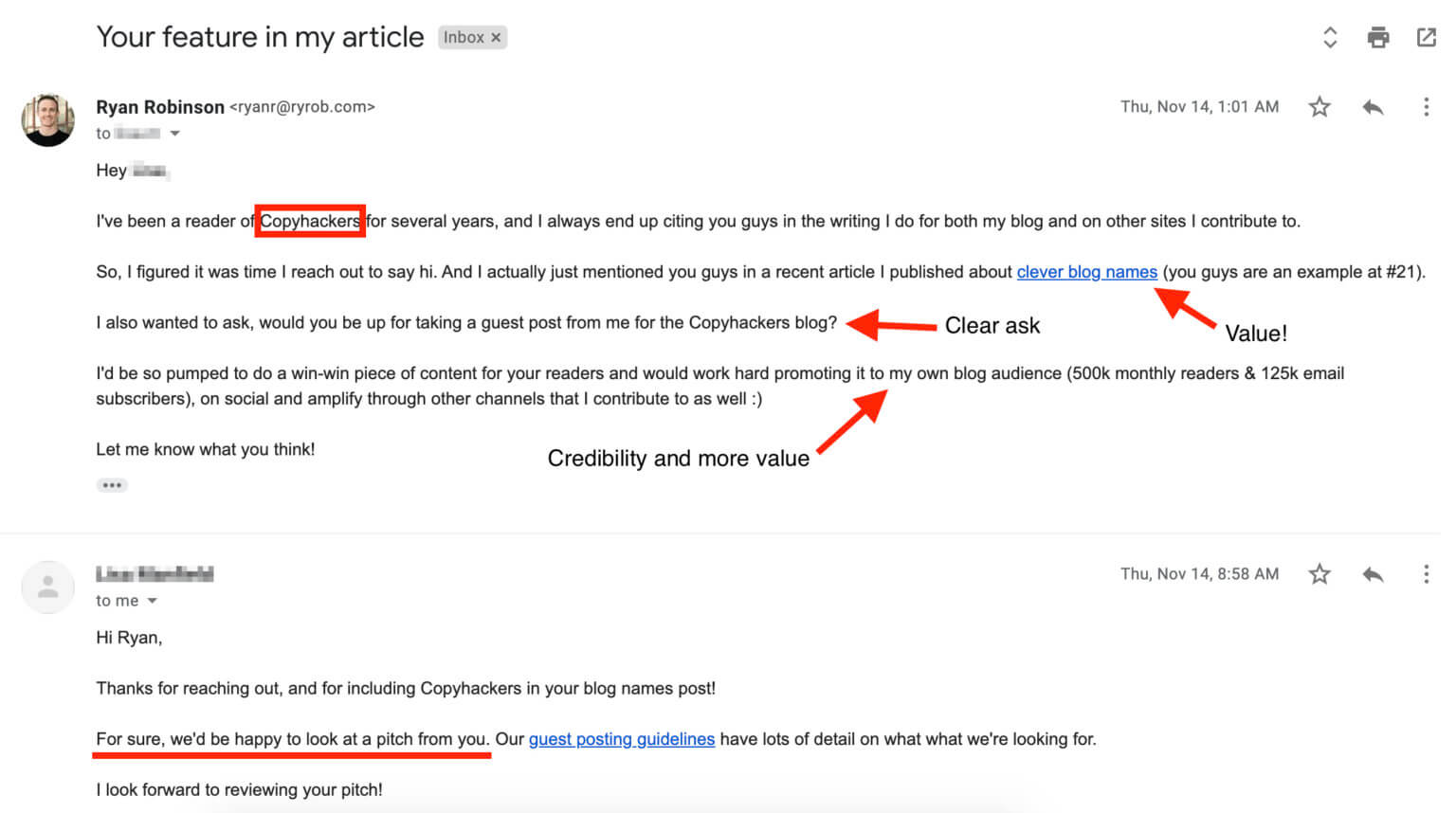
When you mention a contributor in your articles, you can include a quote, a case study, or a story—or you can simply link back to an article or blog post they’ve written… remembering that high-quality earned links are the currency of the Internet and the backbone of an online business.
As I’ve alluded to, you don’t have to limit your mentions to the content you share on your blog, either. Suppose you’re writing for other authoritative blogs or industry-specific publications. In that case, you can also include backlinks or quotes from Forbes, Entrepreneur, or Inc contributors that you want to connect with.
As long as the mention feels natural in your writing, you have an opportunity to email them and tell them that you’ve shared their work meaningfully.
Clearly, if you’ve invested time into learning how to write faster, you’ll be able to publish more content—thus creating more opportunities to network and grow your reach.
When in Doubt… Give, Give, Give, and Give Some More
I’ve mentioned this many times throughout this guide about how to write for publications already, but it’s worth repeating…

Before you ask anything from a contributor, you should first be given. Give over weeks and months before you should feel comfortable making an ask of them.
Work on building a real rapport and strive to be patient enough to learn from them as well. They’ve already achieved the goal you’re hoping to achieve, so pay attention to the steps that got them where they are today. Read the articles they’re publishing and study their style, tone, and appeal.
Don’t stop after you’ve shared a handful of their articles on your social media accounts, either.
Continue finding ways to show that you’re interested in what they’re doing and that you can help them achieve their goals by providing backlinks, testimonials, and reviews.
If you’re able to do that well, then they’ll eventually want to reciprocate the very real value you’ve provided to them.
5. Ask for an Introduction to an Editor at Your Target Publication

By this point in the process, you’ll want to have accomplished the following objectives. Remember, there are no shortcuts unless you have relationships that can get you a contributor account without putting in this kind of work:
- You’ve written for several smaller authority websites (aim for 10 to 20, but the more, the better)
- You’ve done a lot of research about your target publication and the writers you resonate most with
- You’ve reached out to a handful of writers and provided value to them over weeks or months
Now, there’s no way around it… you’ll (most likely) have to eventually ask for an introduction to a relevant editor at your target publication (where your new contributor friend also writes).
By now, this ask should feel at least somewhat natural, organic, and comfortable—and there’s no template for making this kind of request. Once you’ve provided a meaningful amount of value, you’ll know when the time feels right.
What happens if you get turned down on an introduction request?
If you shoot your shot and the contributor replies that it’s not the right time, that they don’t do introductions, or that they don’t think you’re currently a good fit, it’s not the end of the world.
Nor is the door to becoming a contributor to the publication permanently closed. It simply means that one of the following things is (likely) true:
- There’s a genuine reason why now isn’t the right time for an introduction on their end
- You may not yet be as prepared (to be taken seriously as a prospective contributor by an editor) as you think you are
- The value you’ve provided to the contributor doesn’t rise above the threshold they had in mind for something as big as vouching for you in an intro to their editor
You can personally control some of these factors, like working with the contributor on an arrangement around what (and how much) value you can provide to them in exchange for an introduction in the coming months, but you won’t have as much agency with other factors.
It’s a simple truth that not every attempt at forging a path to become a contributor to your dream publication will result in success. You may need to start from the beginning and try your hand at building more relationships over time.
Once you do get an introduction to an editor at your target publication, though, it’s time to craft a stellar pitch for them.
Craft a Great Pitch to a Publication Editor

After you’ve successfully gotten an introduction to an editor of your target publication, you have to keep the momentum rolling forward.
It’s an opportunity that’s taken a lot of work to achieve, and you want to keep that good impression as you craft a great pitch that they’ll want to take immediate action on.
How do you write a pitch for a major publication?
The best first-time contributor pitches should include these four elements:
- A clear beat (topic area) that you’d like to cover
- A handful of great story ideas (including catchy headlines and a description of the article angles)
- A specific callout of the unique value you can provide as a contributor to the publication
- An idea of how you’ll promote your contributed articles (# of blog readers, # of social followers, other sites you contribute to, etc.)
Here’s a screenshot (example) of an editor introduction I made for a friend who wanted to contribute to Forbes, including the exact great pitch she crafted for the editor (you can click the image to expand it, zoom in, and read in detail if you’d like):
(Click here to expand this image)
Let’s explore these elements a little further now. I highly recommend including them in a pitch to an editor, particularly for major publications like Forbes, Entrepreneur, Inc., and the like.
Include Links to 2-3 of Your Best Published Articles (on Reputable Sites)
In your pitch to the editor, be sure to include links to 2-3 of the best articles you’ve published on other reputable sites.
You can also use links to some of the top-performing posts on your blog, particularly if those articles clearly have a lot of shares, views, and comments, to showcase your audience size & engagement. This is the time to show off your hard work and prove that you can deliver quality writing (and an audience) to their publication, so don’t be shy!
Provide Clear Value to the Publication
Aside from being able to provide quality writing, you also need to answer the question of why this publication should want to host you as a contributor!
They already have hundreds (possibly thousands) of other writers, so what makes you beneficial to THEM?
Here’s where you can talk about how you’ll help drive traffic to the publication. Some value propositions you can mention include factors like:
- A sizable readership of your own
- An active email list (where you’ll naturally promote some of your publication articles)
- A decent social media following to boost readership of your contributed articles
In your pitch, clearly state how you can use your influence to send traffic back to their publication.
You can share detailed information, such as exactly how many visitors your blog receives, the size of your email list, and the number of followers you have on social media.
Follow up on Your Email Pitch to the Editor
Editors are extremely busy and naturally receive tons of requests from not only the people they work with, but from existing contributors and other prospective writers (like yourself).
You may have caught their attention in your first email, but it’s easy for them to move on and forget about your original pitch. Don’t be discouraged by any radio silence. Instead, be persistent and continue emailing them (respectfully and at a measured pace) over time.
When you send follow-up emails to a (busy) editor at your dream publication, figure out ways to continue adding value rather than just “checking in” and reminding them that you’re waiting to hear back about your pitch.
Show them how you’ve linked to their publication in the past (do it again), how you plan on continuing to bring them more readers moving forward, and how you’ll be able to drive traffic to the articles you contribute. If you’ve managed to get your writing published on other authority websites, this is the time to mention more of those features, too.
If you feel the idea(s) in your original pitch might not resonate with your editor, send over a few new ideas they can consider and take action on.
Write a Contributor Bio and Include Backlinks (When Applicable)
One of the reasons to write for major publications like Forbes, Entrepreneur, Inc, Fast Company, and Business Insider is to build up your credibility within your industry. However, it’s also a great way to drive traffic back to your blog and increase the Domain Authority of your website.
Most of these publications will allow you to include a bio about yourself. A few years ago, I wrote an article for Entrepreneur titled “6 Millennials Who Quit Their Day Jobs Share How They Did It.” Here’s an example of the bio I included for that article:

The icons below my tagline link to my social media, website homepage and a relevant blog post. I also tastefully included links back to my blog in the main text of the article, like so:

Here’s an example of the bio I crafter for Forbes, which allowed me to include social media links and a direct link to my blog:
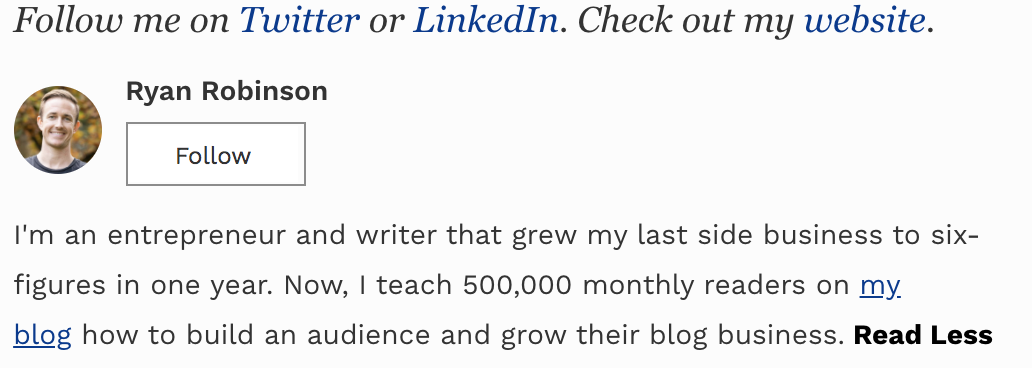
I also incorporated a relevant, value-adding link to my guide about how to start a blog organically in the main text of a recent article I wrote on the 5 Types Of Content Marketing Businesses Can Use To Improve Customer Experience. When done tastefully in a way that adds value to the article as a whole, external links to your own content are usually permissible, like so:
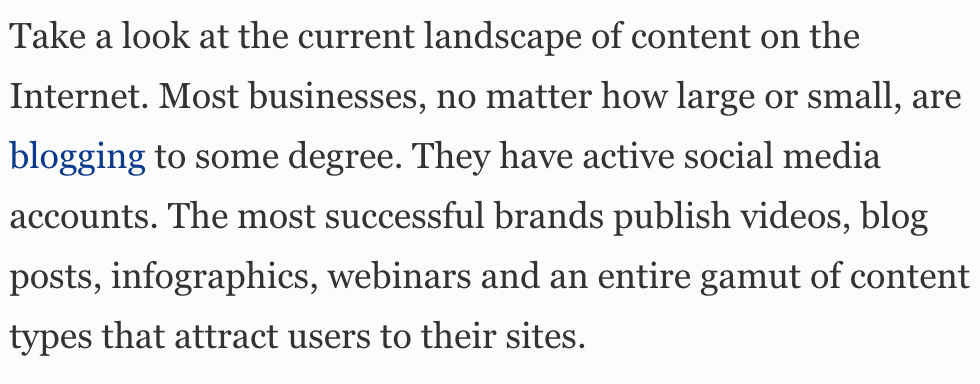
Backlinks to your blog lead to direct traffic and boost your domain authority, which in turn helps your content rank higher in Google search results.
Promote Your Article Once it’s Published
You’ve achieved your dream, and you’re published in a major publication in your industry! Woo! 🎉
Now, it’s time to come through on your promises to the editor during your pitching process. Begin by sharing your published piece with your audience and show that you can live up to the expectations of the publication. You can now help the publication achieve its goal of increasing its readership.
Here’s a quick checklist of where to share your published article after it goes live with:
- Social media followers
- Directly on your blog
- To your email subscribers
- By reaching out to any people or brands mentioned in the article and asking them to share on social too
The more you’re able to prove that you can deliver value to the publication you’re now a contributor to, the more likely they are to accept more of your content in the future.
Use Your Published Article to Build Credibility
Delivering value for your (new) publication is one of the pieces of this puzzle, but improving the credibility of your own blog (or personal brand) is another major reason you’re here in the first place.
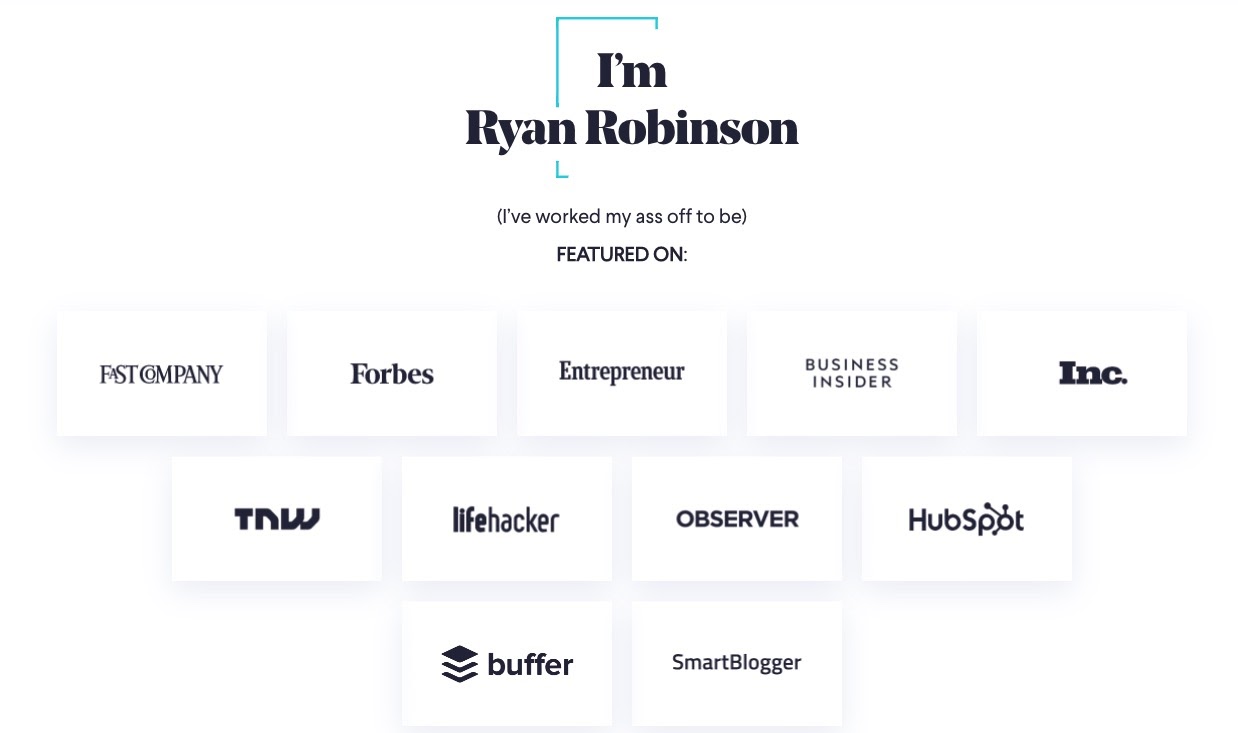
You can (and should) let your audience know when you’ve successfully contributed to a major publication. Here’s a graphic I have on my own homepage showcasing where I’ve written:
For some, this might feel like bragging or showing off. I can understand that impulse—but instead, think of it as building trust between yourself and your readers.
There are a ton of bloggers out there and an insane amount of content on the Internet. You’re letting your readers know you can deliver something that’s worth their time.
If major publications like Fast Company, Forbes, Business Insider, and Entrepreneur have published your work, then there’s a good chance you’re bringing that same quality to your blog, too.
Writing For Major Publications: A Lot of Work… and a Big Payoff
Something I really want to stress about this process is it’s a lot of work. And it should be! You should earn the privilege of having your content shared with (potentially) millions of readers.

Unless you have a direct connection to a decision-maker at a major publication you want to write for, it takes a lot of time and effort to make that pivotal contact point to an editor… and to earn an acceptance.
The good news is that each step along the way will serve to further build your blogging business. Writing guest posts for other authority websites will enhance your credibility, boost your SEO rankings, and help build your relationships with other bloggers in your niche. Networking with contributors to major publications will also help your business and provide future collaboration opportunities.
Writing for a major publication may be one of your top goals, but the road to getting there is also extremely rewarding.
And eventually, once you’re able to add “Contributor at Forbes” or Inc to your resume, it’s a high level up in your career as a blogger, author, founder, or otherwise.
Happy pitching!
Want feedback on your pitch? Advice on your approach to becoming a contributor?
Comment below with your pitch (or application approach), and I’ll weigh in with some feedback & advice 😊

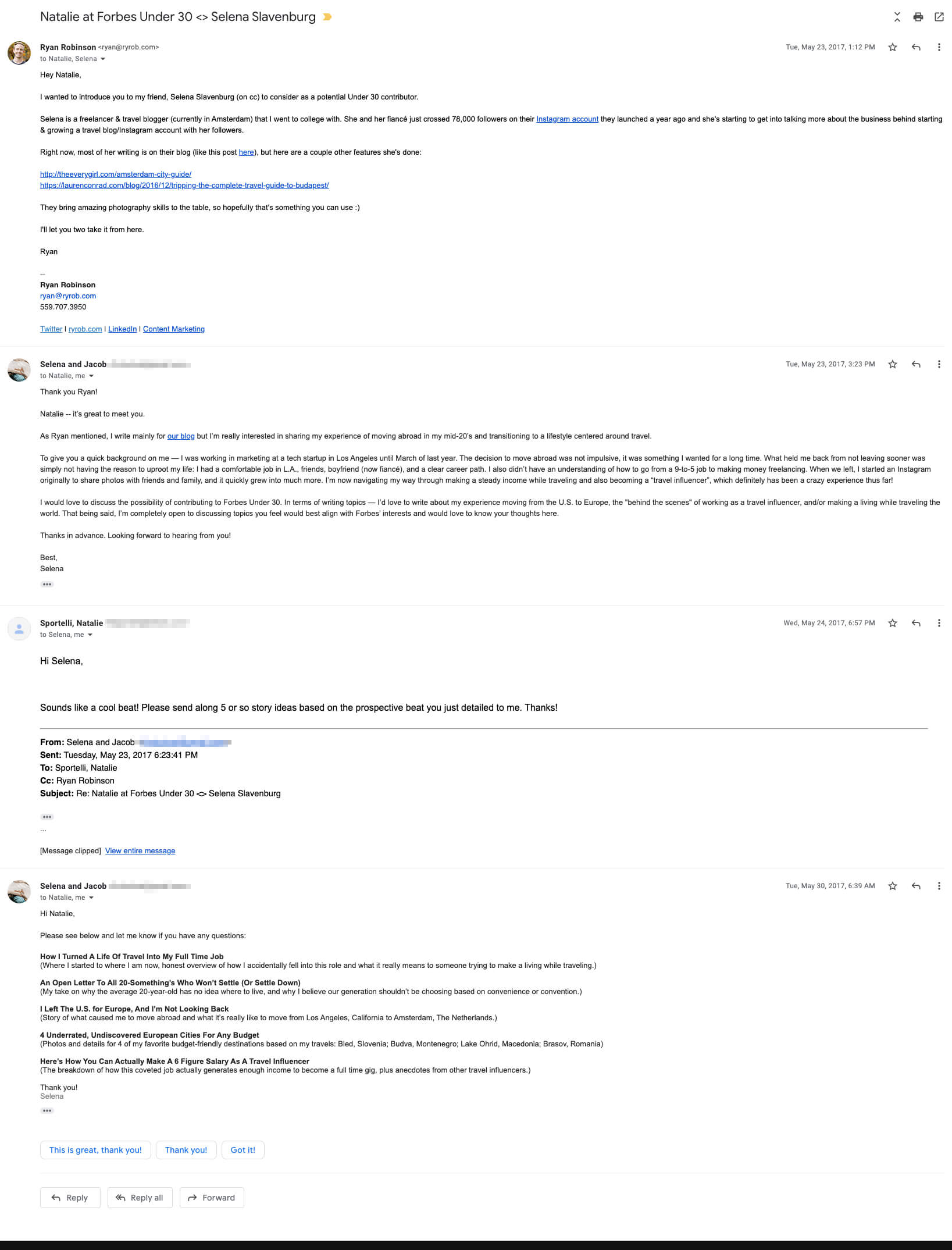
Hey Ryan,
Nice write up. Would be happy to read more stuff like that from you.
Have you tried PR campaigns with data study reports?
How do you find and make a pitch for journos? If not, how would you do it based on your experience? 🙂
Thanks, Vlad! I’ll certainly keep the goods coming 🙏
I don’t personally do much by way of PR campaigns (aside from sporadic interviews I do on podcasts, YT channels, for news outlets, publications)—nothing too systematic in this realm that I’d be able to track as far as high volume pitching to report back on… but generally, unique data & studies definitely tend to spark more interest with editors / writers at publications, so I LOVE that as an approach to stand out from the crowd.
Crafting a pitch for journalists—I talk a bit about that in this guide (above) 🙂 lmk if you have more specific questions though!
Got it, Ryan 🙂
Thanks a lot for the answer. Appreciate it.
🙏
Hey Ryan, thanks for honestly sharing the secrets to get featured on top publications, you’re awesome. As you said, it is a lot of work and it should be. I have been pitching mid-level publications with my recently built portfolio (Jeffbullas) but no luck so far. I realize that when you’re pitching someone, it is not just the pitch they look at, but also they go through your blogs to understand your writing style and knowledge on the subject. I feel it is really hard process for an esl blogger like me to get that sweet spot with just a pitch. So it is really important to have some top-notch content on your blog first before jumping pitching big publications.
I recently got a chance to speak to a Forbes councils member and a contributor about how all this process works and they shared almost the same advice as you’ve shared in this article. They also promised me they’d connect with some editors when I be in touch with ’em.
It breaks down to a simple logic – Improve your writing, start small to have that quality portfolio on the table to pitch next level publications. AND build a lots of network, you never know who can help you achieve your dream.
Thanks again for crafting this masterpiece for us.
You’re so welcome, Mudassir! I really appreciate you (and how often you show up in my little corner of the world 🙏) so thank you too!
You’re right though, it’s A LOT of work to get published on the most coveted (and competitive) publications out there… and you’re very right that it’s more of an uphill battle to get the attention you deserve as an ESL blogger when it comes to well-established (English-only) publications like Forbes, but that’s GREAT you’re making progress with a contributor who can get you an introduction soon. That’s what it’s all about… improving your craft, showcasing great work and putting in the time to build meaningful relationships with the people who can get you in front of decision-makers.
Good luck, my friend! And please keep in touch 🙂
Hey Ryan, hopw you are well. I am also struggling to make it big. I undertand that pitching is not the only thing that can fetch me a writing opportunity with big names. But m style of writing has to be improved.
Despite knowing this i am not abe o pin poi t what needs improvement im m style of writing.
I understand you would get tons of requests like mine. But if it is possible to have look at my Website and give your valuable advice, i would be really happy.
Thanks and keep writing 🙂
I totally understand your struggle, Richa. Wishing you the best of luck in getting published on some solid sites in your niche… I’d suggest taking a step back and actually focusing more on guest blogging instead (for right now) while you build up your brand and get more comfortable with writing for other sites & pitching. Check out my guide here: https://www.ryrob.com/guest-blogging/
Such publications are only needed to attract new visitors. In “technical terms” such articles (links) are of very little use.
Debatable on the link discussion IMO, but yes—primarily for traffic spikes & surges in new email subscribers 🙂
Hello Ryan, enjoyed your article/valuable insight! I am looking to share my passion as a contributing writer for a major publication and have written articles for various websites/publications in addition to my website/blog. It’s great to hear this process takes time… I was beginning to take it personal (smile). I do believe my platform is very timely and relevant in this day and age. I welcome any feedback!
Thank you much!
Ah yes, it always takes time to make inroads at a publication! Keep up the good work you’re doing, get your work published on more and more sites that are a ladder run (or two) down from your top dream publications and eventually you’ll have a really strong case for pitching those bigger editors… or better yet, getting an introduction to one from an existing contributor to your dream sites.
Hey Ryan!
Thank you for this.I am copywriter / ghostwriter a d I am actively trying to hemp one of my Clients break into either Forbes or Entrepreneur.
We’ve been writing g together for a few years now.
I heard that the big 3 (including inc) are doing some sort of “open enrollment” (my words) for new contributors but I have not been able to see anything solid.
Any idea or have you heard this?
Thanks again!
Hey Steven! That’s a great question. To be honest though, an open enrollment from the big publications (which get hundreds of contributor requests a day) seems a bit dubious to me… and if you’re not finding anything specific about it on their official sites when you search around, I wouldn’t personally buy those rumors myself 🙂
Hi Ryan.
Great article….thank you for sharing all of those valuable tips.
I just want to make sure that these ways are to become a paid contributor to these sites, not a fee-based leadership network contributor, right?
James
Hey James! That’s correct, this is the route to becoming a contributor (whether you’re paid for your submissions and have a quota each month or you opt to forego payment & not have a quota). I personally wouldn’t recommend joining any of the fee-based networks unless you have a company willing to cover that cost for you… either way, once you’ve indicated you’re in the pay to play category with any of these publications, it’d be very difficult to break out of that.
You need an editor. There are many errors within this article. I’m surprised because as writer, surely you would know to check your work.
Sending you love, Cheryl <3
A very informative read. Thank you for this good quality knowledge, great work done.
You’re welcome, Jack!
Getting your work out to as many publications as possible will most definitely increase your status as a writer. Great tips shared here!
Absolutely! Thanks, Carola 🙂
AI content writing tools are a valuable resource for anyone looking to produce high-quality written content quickly and efficiently. They can help streamline the writing process and ensure that the content produced is engaging, error-free, and optimized for the target audience.
Absolutely! I couldn’t agree more 😉